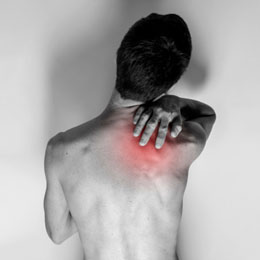A muscle knot is a bundle of muscle fibers that remains taut and is harder than normal. These form when the muscle fibers are unable to relax. This write-up provides information on the contributing factors for the formation of knots in the back.

Muscle knots are medically referred to as myofascial trigger points. These are sore spots that likely to form due to repeated stress on the muscle. Active trigger points are the ones that cause pain. When these are compressed, these cause pain that might also radiate to other parts of the body. Trigger points are called latent, when they do not cause pain, but cause muscle weakness and restrict movement. These points cause the muscle fibers to get shortened even at rest. Trigger points must not be confused with tender points, which are localized areas of tenderness around joints. The former is associated with myofascial pain syndrome, whereas the latter is associated with fibromyalgia.
Why Do Muscle Knots Form in the Back?
The muscles of the neck and back region work in a cycle. These muscles constantly switch over from active to passive mode. Sometimes, repeated stress or trauma causes a reaction in which the muscle is forced to stay in the active or the 'on' mode. When the muscles don't switch over to the passive mode, they are unable to relax. Wrong posture, injury, or overuse of muscles can cause your back muscles to get strained. The strain could be caused due to vigorous physical exercises or even household work. This could give rise to the formation of myofascial trigger points in the back.
There are several theories regarding the formation of such knots. Some medical practitioners believe that these are formed due to the existence of excessive connective tissue around the muscle. There have been where the biopsy results revealed abnormal protein deposits within the tissue. However, there isn't enough conclusive evidence to prove these theories, and these have not really assisted the doctors with any help on treatment options. Whatever the underlying cause may be, this condition can cause a lot of pain and discomfort. Medical assistance must be sought for proper diagnosis and treatment.
Treatment Options
If you have been experiencing moderate to severe back pain due to tightly contracted muscle fibers or knots in your upper or lower back, you can try the following methods to ease your discomfort.
Correct Your Posture
If you have such trigger points in your back, it indicates that you need to bring about certain changes in your lifestyle. You must pay attention to your posture. Make sure that you don't sit hunched up in front of your laptop all the time. Don't sit continuously in the same position for a long time. You must take a break. Use pillows to support your back. Avoid straining your muscles.
Massage
You can try the deep tissue massage or myofascial release massage to ease your discomfort. Though you might experience pain during the massage session, at the end of the session, you will feel a lot of relief. You can also try aromatherapy or acupuncture to alleviate muscle pain.
Application of Heat
You can apply heating pads or microwave gel packs to the affected area. This will help the constricted muscles to relax. Electrical stimulation is another option that is available to you. This will provide some relief, but if the pain persists, you must consult a doctor soon.
Anti-inflammatory Medicines
If you are experiencing severe pain, doctors might prescribe anti-inflammatory drugs or muscle relaxers to ease your pain. Topical application of an analgesic cream or ointment will also prove beneficial.
If you are experiencing severe pain, it would be best to visit a physiotherapist soon. Mild stretching exercises, lifestyle changes, and good dietary habits might also help in preventing the formation of myofascial trigger points in the muscles. Follow your doctor's advice to ease your discomfort and take the preventive steps so that you don't face this problem in future.
Disclaimer:
The information provided in this article is solely for educating the reader. It is not intended to be a substitute for the advice of a medical expert.


 Muscle knots are medically referred to as myofascial trigger points. These are sore spots that likely to form due to repeated stress on the muscle. Active trigger points are the ones that cause pain. When these are compressed, these cause pain that might also radiate to other parts of the body. Trigger points are called latent, when they do not cause pain, but cause muscle weakness and restrict movement. These points cause the muscle fibers to get shortened even at rest. Trigger points must not be confused with tender points, which are localized areas of tenderness around joints. The former is associated with myofascial pain syndrome, whereas the latter is associated with fibromyalgia.
Muscle knots are medically referred to as myofascial trigger points. These are sore spots that likely to form due to repeated stress on the muscle. Active trigger points are the ones that cause pain. When these are compressed, these cause pain that might also radiate to other parts of the body. Trigger points are called latent, when they do not cause pain, but cause muscle weakness and restrict movement. These points cause the muscle fibers to get shortened even at rest. Trigger points must not be confused with tender points, which are localized areas of tenderness around joints. The former is associated with myofascial pain syndrome, whereas the latter is associated with fibromyalgia.